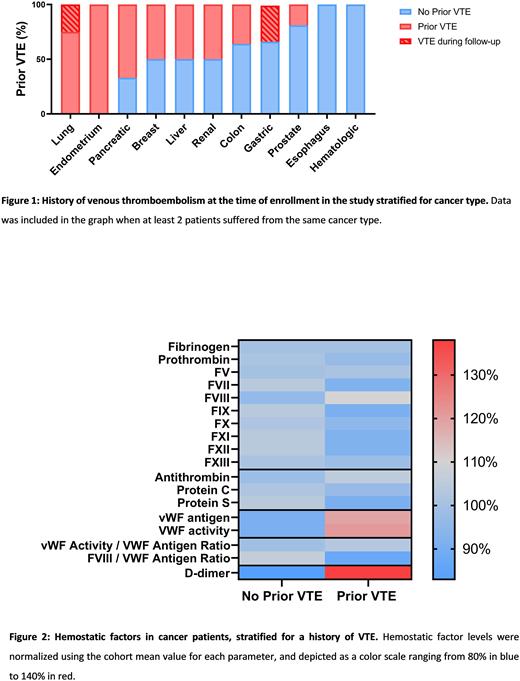Abstract
Background Venous thromboembolism (VTE) and arterial thrombosis are common complications of cancer and cancer treatment. A history of VTE in cancer patients increases the mortality risk by more than 2-fold compared to patients without prior VTE. The risk of cancer-associated thrombosis depends on the type of cancer, anti-cancer treatment and patient related factors. Some cancers have a high risk of thrombosis including lung, pancreas, gastric and brain. Several cancer-related prediction scores, such as the Khorana score or the PROTECHT score are used to predict the risk of thrombosis. Many mechanisms have been proposed through which cancer-related thrombosis may occur, however it remains difficult to predict thrombotic events in individual patients. Thus, accurate prediction of thrombotic events would be useful in the clinic to identify which patient may benefit from pharmacologic thromboprophylaxis. Therefore, we aim to study whether VTE can be predicted in individual cancer patients using hematological parameters.
Methods The Cornell Blood Coagulation in Cancer (COBLOCA) study is an ongoing prospective study of cancer patients seen in a large academic medical center with a follow-up duration of 2 years and a detailed documentation of thrombotic events. We aim to enroll 600 patients with cancer (500 without VTE and 100 with prior VTE). Demographics, type and stage of cancer, treatment, thrombotic events (prior and during study enrollment) and anticoagulation treatment are collected. The levels of fibrinogen, prothrombin, coagulation factor FV, FVII, FVIII, FIX, FX, FXI, FXII, and FXIII, antithrombin, protein C, protein S, von Willebrand Factor antigen and activity, and D-dimer levels were determined in the patient plasma samples. We present an intermediate analysis on the acquired data.
Results A total of 76 patients with cancer have been enrolled in the study to date. The association of prior VTE and the levels of hematological variables in patients with cancer were explored in this intermediate analysis. At baseline, 24 patients (32%) had a prior VTE. Twenty-four patients were on anticoagulants at the time of enrollment, of which 54% were on apixaban, 21% on rivaroxaban, 21% on heparin, and 4% on warfarin. Seven patients used aspirin in addition to anticoagulants, and 10 patients only used aspirin. A history of VTE was most common in patients with lung or endometrial cancer. Patients with esophageal, gastric or hematologic neoplasm did not have a history of VTE at enrollment, although 1 patient with gastric cancer developed a VTE during follow-up. From the remaining patients, 67% of patients with pancreatic cancer, 50% of patients with breast, liver and renal cancer, 36% of patients with colon cancer, and 19% with prostate cancer, previously suffered from VTE (Figure 1). At the time of this intermediate analysis, 3 VTE events were reported during the ongoing follow-up period, 1 in a patient with lung cancer, 1 in a patient with gastric cancer and 1 in a patient with duodenal cancer and history of hereditary hemorrhagic telangiectasia.
Pro- and anticoagulant factor levels were compared between patients with and without a prior VTE. Von Willebrand Factor (VWF) antigen (+31%) and activity (+36%) levels were significantly increased in cancer patients with a history of VTE. The plasma level of FXI was significantly decreased in cancer patients with prior VTE. Additionally, plasma levels of fibrinogen, prothrombin, FV, FVII, FVIII, FIX, FX, FXII, FXIII, antithrombin, protein C, and protein S showed a trend towards lower levels in patients with a prior VTE, although these differences did not reach statistical significance (Figure 2). Moreover, D-dimer levels were significantly higher in cancer patients with prior VTE (551 μg/mL ± 942 μg/mL) than cancer patients without a history of VTE (332 μg/mL ± 451 μg/mL).
Conclusion Both VWF antigen and activity were significantly increased in cancer patients with a history of VTE, indicating that the vessel wall plays an important role in cancer-associated thrombosis. Likewise, elevated D-dimer levels, and reduced levels of available coagulation factors in cancer patients with a history of VTE indicate that these patients might be in a more pro-coagulant state, resulting in (sub-clinical) consumption of coagulation factors and ongoing low grade intra-vascular coagulation.
Disclosures
de Laat-Kremers:Synapse Research Institute: Current Employment. de Laat:Synapse Research Institute: Current Employment.
Author notes
Asterisk with author names denotes non-ASH members.


This feature is available to Subscribers Only
Sign In or Create an Account Close Modal